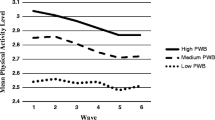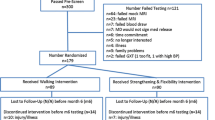Abstract
Background: Physical activity has been effective in enhancing quality of life (QOL) of older adults over relatively short periods of time. However, little is known about the longterm effects of physical activity and even less about the possible mediators of this relationship.Purpose: We examined the mediating effects of psychological variables on the relationship between physical activity and global QOL (satisfaction with life) in older adults over a 4-year period.Methods: Participants (N = 174, M age = 66.7 years) completed a battery of psychosocial measures at 1 and 5 years following enrollment in a 6-month randomized controlled exercise trial.Results: Panel analysis conducted within a covariance modeling framework indicated that physical activity was related to self-efficacy, physical self-esteem, and positive affect at 1 year, and in turn, greater levels of self-efficacy and positive affect were associated with higher levels of QOL. Analyses indicated that changes in physical activity over the 4-year period were related to increases in physical self-esteem and positive affect, but only positive affect directly influenced improvements in QOL.Conclusions: The findings lend support to the position that physical activity effects on QOL are in part mediated by intermediate psychological outcomes and that physical activity can have long-term effects on well-being.
Similar content being viewed by others
References
U.S.CensusBureau:Population Profile of the United States:2000 (Internet Release). Retrieved November 25, 2003, from http:// www.census.gov/population/pcp-profile/2000/profile2000.pdf.
Keysor JJ: Does late-life physical activity or exercise prevent or minimize disablement? A critical review of the scientific evidence.American Journal of Preventive Medicine. 2003,25(3):129–136.
Miller ME, Rejeski WJ, Reboussin BA, Ten Have TR, Ettinger WH: Physical activity, functional limitations, and disability in older adults.Journal of the American Geriatrics Society. 2000,48:1264–1272.
McAuley E, Blissmer B, Marquez DX, et al.: Social relations, physical activity, and well-being in older adults.Preventive Medicine. 2000,31:608–617.
Rejeski WJ, Brawley LR, Shumaker SA: Physical activity and health-related quality of life.Exercise and Sports Sciences Reviews. 1996,24:71–108.
Stewart AL, King AC: Evaluating the efficacy of physical activity for influencing quality-of-life outcomes in older adults.Annals of Behavioral Medicine. 1991,13(3): 108–116.
Ware JE, Kosinski M, Keller SK:SF-36® Physical and Mental Health Summary Scales: A User’s Manual. 1994, Boston: The Health Institute.
Rejeski WJ, Mihalko SL: Physical activity and quality of life in older adults.Journals of Gerontology. Series A, Biological Sciences and Medical Sciences. 2001,56(2):23–35.
McAuley E, Elavsky S: Physical activity, aging, and quality of life: Implications for measurement. In Zhu W (ed),Measurement Issues and Challenges in Aging Research. Champaign, IL: Human Kinetics, 2004.
Diener E: Subjective well-being.Psychological Bulletin. 1984,95:542–575.
Diener E, Scollon CN, Lucas RE: The evolving concept of subjective well-being: The multi-faceted nature of happiness. In Costa PT, Siegler IC (eds),Advances in Cell Aging and Gerontology. Amsterdam: Elsevier, 2003, 187–220.
Rosenberg M:Society and the Adolescent Self-Image. Princeton, NJ: Princeton University Press, 1965.
Lachman ME, Weaver SL: The sense of control as a moderator of social class differences in health and well-being.Journal of Personality and Social Psychology. 1998,74:763–773.
Stewart AL, Mills KM, Sepsis PG, et al.: Evaluation of CHAMPS, a physical activity promotion program for older adults.Annals of Behavioral Medicine. 1997,19:353–361.
McAuley E, Blissmer B, Katula J, Duncan TE, Mihalko SL: Physical activity, self-esteem, and self-efficacy relationships in older adults: A randomized controlled trial.Annals of Behavioral Medicine. 2000,22:131–139.
Sonstroem RJ, Harlow LL, Josephs L: Exercise and self-esteem: Validity of model expansion and exercise associations.Journal of Sport & Exercise Psychology. 1994,16:29–42.
McAuley E, Blissmer B: Self-efficacy determinants and consequences of physical activity.Exercise and Sport Science Reviews. 2000,28(2):85–88.
Bandura A:Self-Efficacy: The Exercise of Control. New York: Freeman, 1997.
Emery CF, Shermer RL, Hauck ER, Hsiao ET, MacIntyre NR: Cognitive and psychological outcomes of exercise in a 1-year follow-up study of patients with chronic obstructive pulmonary disease.Health Psychology. 2003,22:598–604.
Boileau RA, McAuley E, Demetriou D, et al.: Aerobic exercise training and cardiorespiratory fitness in older adults: A randomized control trial.Journal of Aging and Physical Activity. 1999,7:374–385.
McAuley E, Katula J, Mihalko SL, et al.: Mode of physical activity and self-efficacy in older adults: A latent growth curve analysis.Journals of Gerontology. Series B, Psychological Sciences and Social Sciences. 1999,54:283–292.
Kramer AF, Hahn S, Cohen NJ, et al.: Ageing, fitness and neurocognitive function.Nature. 1999,400:418–419.
Washburn RA, Smith KW, Jette AM, Janney CA: The Physical Activity Scale for the Elderly (PASE): Development and evaluation.Journal of Clinical Epidemiology. 1993,46(2): 153–162.
Washburn RA, McAuley E, Katula J, Mihalko SL, Boileau RA: The Physical Activity Scale for the Elderly (PASE): Evidence for validity.Journal of Clinical Epidemiology. 1999,52:643–651.
Martin KA, Rejeski WJ, Miller ME, et al.: Validation of the PASE in older adults with knee pain and physical disability.Medicine & Science in Sports & Exercise. 1999,31:627–633.
Diener E, Emmons RA, Larsen RJ, Griffin S: The Satisfaction With Life Scale.Journal of Personality Assessment. 1985,49(1):71–75.
Pavot W, Diener E: Review of the Satisfaction With Life Scale.Psychological Assessment. 1993,5:164–172.
Pavot W, Diener E, Colvin CR, Sandvik E: Further validation of the Satisfaction with Life Scale: Evidence for the cross-method convergence of well-being measures.Journal of Personality Assessment. 1991,57(1):149–161.
Fox KR, Corbin CB: The Physical Self-Perception Profile: Development and preliminary validation.Journal of Sport & Exercise Psychology. 1989,11:408–430.
McAuley E: Self-efficacy and the maintenance of exercise participation in older adults.Journal of Behavioral Medicine. 1993,16:103–113.
Kozma A, Stones MJ: The measurement of happiness: Development of the Memorial University of Newfoundland Scale of Happiness (MUNSH).Journal of Gerontology. 1980,35:906–912.
Webster JD: Attachment styles, reminiscence function, and happiness in young and elderly adults.Journal of Aging Studies. 1998,12:315–330.
Kozma A, Stones MJ: Predictors of happiness.Journal of Gerontology. 1983,38:626–628.
Arbuckle JL, Wothke W:AMOS 4.0 User’s Guide. Chicago: SPSS, 1996.
Arbuckle JL: Full information estimation in the presence of incomplete data, inAdvanced Structural Equation Modeling: Issues and Techniques, GA Marcoulides and RE Schumacker, Editors. 1996, Lawrence Erlbaum Associates, Inc.
Enders CK: The impact of nonnormality on full information maximum-likelihood estimation for structural equation models with missing data.Psychological Methods. 2001,6:352–370.
Enders CK, Bandalos DL: The relative performance of full information maximum likelihood estimation for missing data in structural equation models.Structural Equation Modeling. 2001,8:430–457.
Kessler RC, Greenberg DF:Linear Panel Analysis. Models of Quantitative Change. New York: Academic, 1981.
Jöreskog KG, Sörbom D:LISREL 8: User’s Reference Guide. Lincolnwood, IL: Scientific Software International, 1996.
Browne MW, Cudeck R: Alternative ways of assessing model fit. In Bollen KA, Long JS (eds),Testing Structural Equation Models. Beverly Hills, CA: Sage, 1993, 136–162.
Hu L, Bentler PM: Cutoff criteria for fit indices in covariance structure analysis: Conventional versus new alternatives.Structural Equation Modeling. 1999,6:1–55.
Bentler PM: Comparative fix indexes in structural models.Psychological Bulletin. 1990,107:238–246.
Bentler PM, Bonett DG: Significance tests and goodness of fit in the analysis of covariance structures.Psychological Bulletin. 1980,88:588–606.
Schechtman KB, Ory MG: The effects of exercise on the quality of life of frail older adults: A preplanned meta-analysis of the FICSIT trials.Annals of Behavioral Medicine. 2001,23:186–197.
Biddle SJH: Emotion, mood, and physical activity. In Biddle SJH, Fox KR, Boutcher SH (eds),Physical Activity and Psychological Well-Being. New York: Routledge, 2000, 63–87.
Salmon J, Owen N, Crawford D, Bauman A, Sallis JF: Physical activity and sedentary behavior: A population-based study of barriers, enjoyment, and preference.Health Psychology. 2003,22:178–188.
Bandura A:Social Foundations of Thought and Action: A Social Cognitive Theory. Englewood Cliffs, NJ: Prentice Hall, 1986.
Ware JE, Sherbourne CD: The MOS 36-item short-form health survey (SF-36). I. Conceptual framework and item selection.Medical Care. 1992,30:473–483.
Speight J: Assessing the impact of diabetes screening on quality of life or quality of health? Semantics are important.Diabetes Care. 2002,25:1893–1894.
Beckie TM, Hayduk LA: Using perceived health to test the construct-related validity of global quality of life.Social Indicators Research. 2004,65:279–298.
Author information
Authors and Affiliations
Corresponding author
Additional information
Funding for this study was provided by the National Institute on Aging (AG 12113).
About this article
Cite this article
Elavsky, S., McAuley, E., Motl, R.W. et al. Physical activity enhances long-term quality of life in older adults: Efficacy, esteem, and affective influences. ann. behav. med. 30, 138–145 (2005). https://doi.org/10.1207/s15324796abm3002_6
Issue Date:
DOI: https://doi.org/10.1207/s15324796abm3002_6




